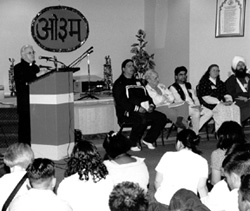Reaching out in dialogue
INTERRELIGIOUS DIALOGUE... AN INTEGRAL PART OF MISSION
By Fr. Ray O’Toole, S.F.M.
March 2002
Return to Table of Contents
Print Article
In the 15th century Matteo Ricci, a Jesuit missionary to China, attempted to express certain aspects of Chistianity in the culture of the Chinese. There was much resistance to such ‘cultural adaptation’ and it was a long time before this became part of the Church’s teaching and looked upon as a requirement of missionary activity.
 Fr. O’Toole (L) speaks about the Christian faith as a panelist at an interfaith event sponsored by Scarboro Missions and the Vedic Cultural Centre, a Hindu temple in Markham, Ontario. The event drew 500 participants.
Fr. O’Toole (L) speaks about the Christian faith as a panelist at an interfaith event sponsored by Scarboro Missions and the Vedic Cultural Centre, a Hindu temple in Markham, Ontario. The event drew 500 participants.
Another aspect of missionary activity has been work on behalf of justice. Although present in the life of the missionary over the years, this work was not articulated in Church teaching as an integral part of the preaching of the gospel until 1974. More recently, the Church has named interreligious dialogue as an essential part of the missionary identity for both priest and lay missionaries.
Since the time of Vatican II, interreligious dialogue has been seen more and more as an integral part of mission. Vatican II speaks of the importance of interreligious dialogue, however, it does not single out interreligious dialogue as an integral part of mission. Only in later Church documents do we see dialogue listed as one of the principal elements of mission.
The document, Dialogue and Mission, produced by the Secretariat for Non-Christians in 1984, mentions interreligious dialogue as part of the Church’s work of mission. The Asia synod document, Ecclesia in Asia, proclaimed by Pope John Paul II in New Delhi, India, November 1999, uses these words: “Interreligious dialogue is more than a way of fostering mutual knowledge and enrichment, it is a part of the Church’s mission to all peoples.”
Scarboro Missions has made interreligious dialogue a priority for mission and a prominent part of our formation programs for priest and lay missionaries. As well, the Society has established an Interfaith Desk and promotes interreligious dialogue both here in Canada and overseas.
Pope John Paul II has shown leadership in this field. His Assisi gatherings of heads of world religions is an example, as well as his visits to mosques, temples and synogogues on his world travels.
In the mission areas where they serve, Scarboro missionaries show leadership by reaching out in dialogue with leaders and followers of other faith traditions.
Reconciliation is central to priesthood. In a world where there is still much prejudice even among the religions, the need to work toward reconciliation is of high priority. It is the teaching of the Church that God works in and through other religions, that there is truth and goodness in these religions and they contribute to the Reign of God in our midst. We need to begin to break down walls that separate us so that we can work together for God’s Reign of justice, peace and love. This begins with dialogue.
Another aspect of the priesthood is its prophetic role. We see some Christians who hold a disdain for other religions. We know this is wrong. The missionary priest is to be prophetic by pointing toward a path of dialogue as this is an integral part of mission.
Fr. Ray O’Toole is Assistant General on Scarboro Missions General Council and coordinator of Scarboro’s Interfaith Desk.
Return to Table of Contents
Print Article